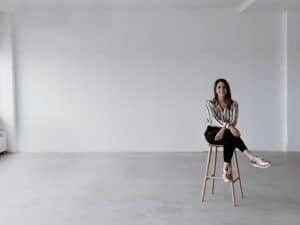
Véronique Chayer
President & Partner, Folio Design
Does your office reflect your company culture?
April 5, 2022 - Be in the Know
In the SpotlightHealth measures are loosening. More and more people are returning to the workplace; some, in fact, can’t wait to get back to the office. But others are not so keen on a return to the cubicle. And once again, the conversation has turned to the kind of workspaces people want. The flexibility offered by telework or hybrid models has forced employers to adapt and offer a workspace that meets employees’ needs and strengthens company culture.
We discussed this topic with Véronique Chayer, founder of Folio Design. For her, it’s “about striking a balance between management’s vision and that of employees. In other words, how do you meet everyone’s expectations?”
And, what’s the best way to go about it?

Why do we need an office?
The workspace plays a bigger role than simply attracting teams to the office: it can even reinforce your company culture and employer branding. But, there’s a practical side to everything: first and foremost, the space needs to be functional and not just esthetically pleasing.
You should be asking yourself the following questions: Why do we need an office? Is it to socialize? To hold videoconferences? To perform tasks that require more concentration? To brainstorm together?
Designing the ideal office space will depend on your answers to the above, but also on the experience that you want to create. You need to think of the office as an extension of the company or as an expression of its culture. How can you create a space that reflects the organization’s culture and the company’s values that also meets the needs of its employees and takes a wide range of profiles (generation, experience, type of responsibilities) into account?
Next, you need to think about offering a variety of workspaces. Your layout will call for individual workspaces, whether standing, sitting, private or open, but also spaces for different uses: different-sized rooms for different functions. And there still needs to be a sense of harmony between the common areas, bistro corner or lunch area, gym or wellness room, not to mention saving some room for the WOW spaces that define your employer branding.
What about technology?
Although people are returning to the office, virtual meetings are here to stay. In the past few years, we’ve witnessed first-hand how technology can be a plus.
Special attention should be given to optimizing technological tools for employees returning to work. Screens, connectivity, sound, acoustics: everthing must be carefully considered so that technology can be used without distracting colleagues at other workstations.
“We’ve really changed how we approach things now. We talk a lot about connecting people interactively and physically. As a matter of fact, the return to work is going much more smoothly than anticipated,” says Véronique.
At the end of the day, when considering your office layout you need to factor in your company’s and your employees’ interests. You need to carefully think about how office furniture is arranged and what materials to use to allow people to circulate easily and keep your teams’ needs in mind.
La tête chercheuse example
“When the pandemic hit, we had no idea what the ‘office of tomorrow’ meant anymore. Many entrepreneurs in a wide range of sectors put their decisions on hold. La tête chercheuse was one of them.

Now, we can see what coming back to the office will be like, but within a specific framework,” as Véronique explains. “There were important elements to consider: being able to concentrate in the workspace, so definitely acoustics. For a year and a half, we got used to working in the calm of our homes, and we were responsible for managing our noise levels and comfort. Now we have to bring back this comfort for everyone, the office community. We need to create zones where we can be away from the noise. Different work zones, with more private and more open workspaces.”
There’s always a solution: for example, acoustic ceilings that absorb sound, which is why the choice of materials is so important.

But we also have to bear in mind that we will have to learn to live together again. “We’ll need to be patient and remind ourselves that we’re no longer used to working like this. Humans, however, are not meant to work alone: we thrive on contact with each other. In general, the most innovative ideas stem from teamwork. Otherwise, our interactions become programmed, organized according to subject and schedule,” insists Véronique.

The key takeaway: flexibility!
In the end, flexibility rules. Spaces have to be flexible, but so do companies. They have to allow employees to manage their schedules and time at the office. The workspace has to factor in this new reality. You have to see it not merely as a space, but a reflection of who you truly are.



